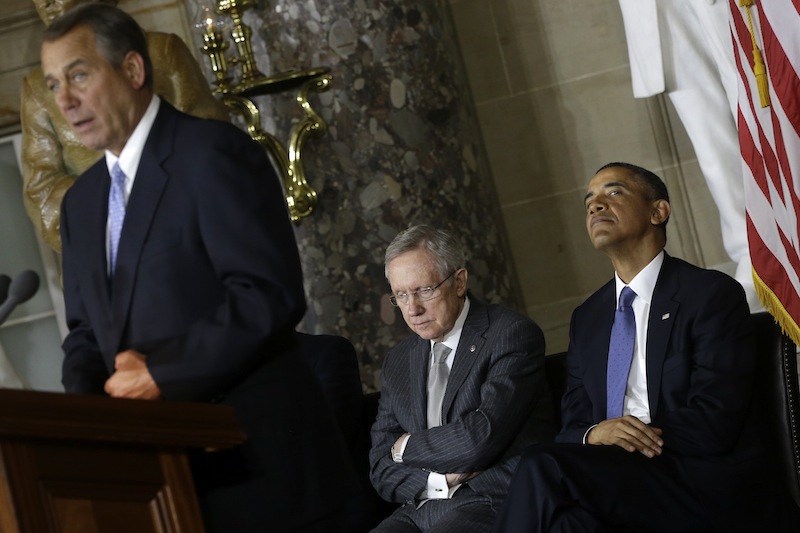The ongoing government shutdown has its roots in a series of fiscal battles incited by tea party Republicans after they won control of the House of Representatives in the 2010 elections. The aim each time has been to use the threat of chaos as leverage to extract budgetary concessions from President Barack Obama and a Democratic-led Senate.
The era of crisis governance that ensued never ended in a government shutdown — until now. Debt default has always been avoided — so far. But the acrimony between the two parties is at an all-time high and the endgame is unclear as the two deadlines converge this month.
Here’s a timeline of each of the fights to avert shutdown and debt default.
Spring 2011: Government Funding
The first-ever fiscal showdown under Speaker John Boehner (R-OH) began and ended with the House Republicans in the driver’s seat against a Democratic Party reeling from their shellacking in the 2010 elections. After briefly extending a March deadline, Boehner and Senate Majority Leader Harry Reid (D-NV) struck a deal that cut close to $40 billion in spending and funded the government through September.
Summer 2011: Debt Limit
A few months later, Republicans used the threat of a catastrophic default on U.S. debt to coerce Democrats into giving up huge spending concessions to lift the debt limit — most notably across-the-board cuts known as the sequester, which continues to haunt them till this day.
Negotiations throughout July between the White House and House GOP leaders on a $4 trillion “grand bargain” collapsed just days before the early August deadline and brought the country within 48 hours of disaster. Congressional leaders scrambled and eventually settled on a plan to lift the debt ceiling through the 2012 election. The Budget Control Act included more than $2 trillion in 10-year spending cuts. Half of the cuts indiscriminately slashed domestic and defense programs and were never supposed to take effect, but rather encourage Congress to reach a comprehensive deal via a “super committee.”
Fall 2011 — Election 2012: Autopilot
The new spending caps established by the debt limit agreement provided a baseline for Congress to keep the government operational through the 2012 election. Republicans refused to accept new tax revenues and Democrats refused to accept further spending cuts otherwise. What ensued in the interim was a series of continuing resolutions, often involving horsetrading and brinkmanship, that always ended up averting a shutdown.
First came a six-week measure late in September. Then a one-month spending bill. And then a nine-month bill to get through the following September.
By the time the summer of 2012 rolled around, conservatives decided to contain their hunger for another confrontation as they sought after the ultimate prize in the presidential election. By the end of July, congressional leaders agreed to a six-month continuing resolution to keep the government funded at Budget Control Act levels.
Winter 2013: Debt Limit Deadline
After a crushing defeat in the election, and a shrunken House majority, Republicans scrambled to find a way to lift the debt ceiling ahead of the coming deadline. Boehner initially demanded more spending cuts and reforms, but this time Obama and Democratic leaders had learned their lesson and vowed not to negotiate again on the debt limit. Boehner promptly caved and persuaded House Republicans to raise the borrowing limit with one string attached: Senate Democrats must pass a (nonbinding) budget resolution, which they had not done in four years, or have their pay withheld. “No budget, no pay,” he called it.
In return, Boehner promised his members he would follow through in the next debt limit deadline and force Democrats to put the country on a path to a balanced budget. And so the crisis was averted well ahead of time. Congress voted to extend the debt limit and Senate Democrats agreed to pass a budget.
Spring 2013: Government Funding
One week before the shutdown deadline, Congress passed legislation to keep the government running for six months. Still reeling from their election defeat, Republicans keep their demands relatively modest: maintain the lower spending levels under the Budget Control Act but give some government agencies flexibility to avoid the worst impacts of sequestration, which took effect in January 2013. Democrats acquiesced. They shook hands.
Fall 2013: Government Funding And Debt Limit
That brings us to the current crisis. Conservatives were determined to use Oct. 1 shutdown deadline and an Oct. 17 debt limit deadline as leverage to extract concessions. Between Boehner’s promises to Republicans, the right’s eagerness to stop Obamacare ahead of its Oct. 1 rollout, and a variety of other factors, his task would be much tougher this time.
First, conservatives thwarted Boehner’s attempts to pass a “clean” continuing resolution and forced him into a fight to dismantle the health care law. Senate Democrats brushed him off. The government shut down, for the first time since 1996, and Boehner has since refused to permit a vote to reopen it cleanly.
Meanwhile, Obama and Reid again refuse to negotiate on the debt limit. The cataclysmic threat posed by failing to act in time has compelled Boehner to consider lifting the debt ceiling with Democratic votes, if need be. But publicly he’s still insisting that the U.S. will default if Democrats don’t acquiesce to policy concessions.
How the fight ends is anybody’s guess. What’s clear is it won’t end until one side is knocked out.






